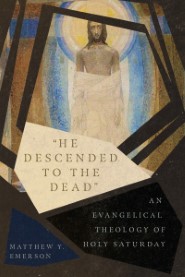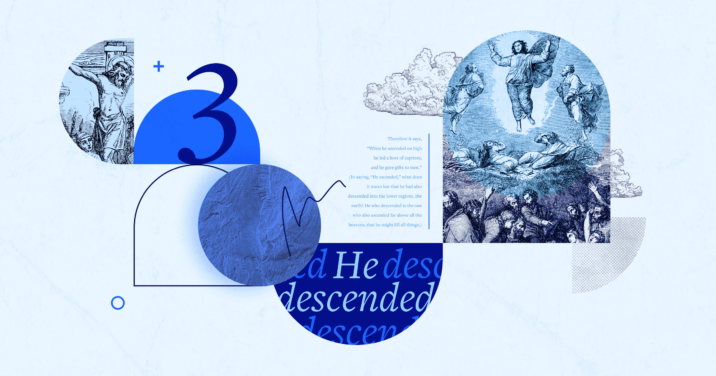Jesus’s crucifixion and resurrection rightly get the emphasis in both academic and pastoral treatments of Christ’s work. The cross and the empty tomb are the crux of God’s work of salvation, the fulcrum on which everything else included in that work—Christ’s active obedience, his ascension, etc.—hinges. What is often omitted from our understanding of the Triduum, the three days of Christ’s Passion, is the final day, the day of Christ’s descent to hell.
While certain Christian traditions, including Roman Catholicism, Eastern Orthodoxy, and Reformed Protestantism (especially Anglicanism and Presbyterianism) have robust doctrines of the descent, the differences between these traditions in their understanding of the descent clause in the Apostles’ Creed—and whether it even refers to Holy Saturday—has resulted in confusion among Christians about how to think about both the clause and the liturgical day. Additionally, in much ecclesial practice, Holy Week includes services on Palm Sunday, Maundy Thursday, Good Friday, and Easter Sunday, while the activity for Holy Saturday is an Easter egg hunt for the church’s and community’s children.
What, then, should we say about Holy Saturday? Most importantly, what does the Bible say about it? What does Scripture say about what happened after Jesus died and before he rose from the dead?
Jesus died a truly human death
First, Scripture affirms that Jesus experienced death as all other humans who pass away before Christ’s return experience it. His human body was interred (John 19:38–42) and his human soul departed to the place of the dead.
The former is not debated; virtually everyone agrees Jesus was buried. What is debated is the latter claim, that Jesus, via his human soul, resided in the place of the dead between his death on the cross and his resurrection from the dead.
Another way to say this is that some Christians deny that a disembodied, conscious, intermediate state is taught in Scripture and, therefore, they deny that Jesus experienced such an intermediate state during the time between his death and resurrection.
The reality, though, is that Scripture does affirm an intermediate state and that Jesus experienced it as all humans do. In Second Temple Judaism, the most common view of the afterlife—one reflected in Jesus’s language in the Gospels—expected indeed an intermediate state in a place called Sheol (Hebrew) or Hades (Greek). All of the dead, righteous and wicked, enter this state, but they enter distinct compartments. The New Testament speaks of the righteous entering “Abraham’s Bosom” (Luke 16:22) or “Paradise” (Luke 23:43). It speaks of the wicked heading to “Gehenna” (Matt 5:22) or Sheol/Hades (Luke 16:19–31). Tartarus is reserved for imprisoned angels and other rebellious spirits (1 Pet 3:19; 2 Pet 2; Jude 6).1
Run a Bible Word Study on gehenna, on sheol, on hades, or on Tartarus in the Logos Bible Study app. Get it free, if you don’t already have it.
Jewish believers of the Second Temple period saw these various compartments as temporary holding places until the anticipated general resurrection. Only after all the dead rose would the judgments on the residents of Sheol/Hades be everlasting (Rev 20:11–15).
Did Jesus’s own soul enter one of these compartments between his death and resurrection? The doctrine of the descent says yes: Jesus, who had a human soul, maintained consciousness in an intermediate state. Specifically, he journeyed to the place he himself called Abraham’s Bosom, or Paradise. Jesus went where the righteous dead go (see Matt 12:40; Luke 23:43; Acts 2:27–31; Rom 10:7).2
Looking at these individual passages, we find in each of them a basic affirmation that Jesus experienced death as all humans do, and as the Old Testament describes and as Second Temple Judaism understood it.
In Matthew 12:40, Jesus draws a direct analogy between Jonah’s experience in the belly of the fish and his own coming time in the tomb. And, when we look at Jonah, we see clearly that John 2 compares that time in the fish to conscious experience in the place of the dead.3
In Acts 2:27, Peter quotes Psalm 16:10 in reference to what happened to Jesus after he died. In both texts, the reference is to the fact that Jesus went to the place of the dead via his human soul, as all humans do upon death, but he was not left or “abandoned” there.4
The same is true of Romans 10:7, where Paul quotes Deuteronomy 30:13 in reference to Jesus’s own death and resurrection. In both texts, Paul and Moses refer to the abyss and the sea, respectively, to refer to the place of the dead.5 Perhaps most explicitly, in Luke 23:43 Jesus tells the thief on the cross, “Today, you will be with me in Paradise.” This is refers not only to the place of the dead but more specifically to the place of the righteous dead.6
The point, then, is simple: in the New Testament, Jesus and the apostles describe what happens to Jesus after he dies in the same way that the Bible describes what happens to all humans when they die. Jesus’s human body is buried and his human soul departs to the place of the dead. Because he is a (the only truly) righteous person, his human soul resides in Paradise, or Abraham’s Bosom, the place of the righteous dead.
Jesus proclaimed his victory over death to the dead
But the New Testament doesn’t stop at saying that Jesus really died. While he experienced death as all humans do, he wasn’t and isn’t merely a human being. He is fully human, but he is fully human as God the Son incarnate. In other words, he is fully human and fully divine.
Because of his hypostatic union, which did not cease at the point of his death but rather continued; because of his sacrificial death, which once and for all cancelled the penalty for sin for those who trust in him; and, ultimately, because of his resurrection, Jesus not only experienced death but also achieved victory over death (Col 2:13–15; Heb 2:14–15).
Because of the victorious nature of his death and resurrection, Jesus also can and does proclaim his victory over death to those in the various locales he visits after his crucifixion.7 He is king of kings, meaning he is king over those under the earth, on the earth, and in heaven (Phil 2:10). He announces his kingship, secured by his victorious death and resurrection, to the dead while he resides in the place of the dead according to his human soul.
The key text in this regard is 1 Peter 3:19. While there has been much debate over the proper exegesis of this passage, the simplest and most exegetically sound way to read it is to understand it as a reference to Christ’s proclamation of his victory to all those in the place of the dead, including imprisoned spirits who reside in the lowest level of Sheol.8 One might say that this is Jesus’s first stop on his “victory tour”: he proclaims his victory first to those in the place of the dead in his descent, and then to those on earth in his resurrection, and finally to those in heaven in his ascension.
Jesus releases the righteous dead from the prison of death
Finally, in his descent to the dead and subsequent resurrection, Jesus releases the righteous dead from the prison of death. Through his death and resurrection, he now holds the keys to Death and Hades (Rev 1:18) and therefore can and does release the righteous dead from what was previously an unassailable and inescapable fortress.9 The key text in this regard is Ephesians 4:8–10, in which Paul proclaims,
Therefore it says, “When he ascended on high he led a host of captives, and he gave gifts to men.” (In saying, “He ascended,” what does it mean but that he had also descended into the lower regions, the earth? He who descended is the one who also ascended far above all the heavens, that he might fill all things.)
While some have argued that the reference to Christ’s descent in Ephesians 4:10 is either the incarnation or Pentecost, the phrase “the lower regions, the earth” is clearly—in Greek and in the two-tiered cosmology of Ephesians—a reference to the place of the dead.10 In other words, Paul refers here to Christ’s descent to the dead, and therefore his quote of Psalm 68 in Ephesians 4:8 in reference to Jesus leading “a host of captives” is an action that culminates his descent and happens at his resurrection.
Jesus descends to the place of the dead and leads out the righteous dead at the end of his time in the tomb; that is, at his resurrection from the place of the dead. This isn’t resurrection for the righteous dead, but it is dwelling in the presence of the risen and ascended Lord Jesus, the sign in their midst of their own impending bodily resurrection at Christ’s return.
Conclusion
So, what happened after Jesus died? He experienced death as all human beings do: his human body was interred (in his case, buried) and his human soul departed to the place of the dead. Because he is both fully human and fully divine, and because he has defeated death in his own death and resurrection, he also is victorious over death. While with the dead, he proclaims to them his victory over death.
And, finally, in his victory over death, he releases the righteous dead from the prison of death, and they dwell with him now in the heavenly places.
Recommended resources

“He Descended to the Dead”: An Evangelical Theology of Holy Saturday
Regular price: $19.99
The Christian Doctrine of Humanity (Explorations in Constructive Dogmatics)
Regular price: $34.99
Ephesians (Baker Exegetical Commentary on the New Testament | BECNT)
Regular price: $52.99
Related articles
- What Is Holy Week?
- Today You Will Be with Me in Paradise: What Did Jesus Mean?
- Who Did Jesus Forgive on the Cross—and Why?
- On Sheol in the Old Testament and in relation to the New Testament texts mentioned, see Matt Emerson, “What Is Sheol?,” Desiring God, July 13, 2020.
- See Matt Emerson, “Christ’s Descent to the Dead,” The Gospel Coalition.
- See my treatment of Matthew 12:40 in relation to Jonah 2 in Matthew Y. Emerson, “He Descended to the Dead”: An Evangelical Theology of Holy Saturday (Downers Grove, IL: InterVarsity Press Academic, 2019), 35–39; and idem, “Mapping Anthropological Metaphysics with a Descensus Key: How Christ’s Descent to the Dead Informs the Body-Mind Conversation,” in The Christian Doctrine of Humanity: Explorations in Constructive Dogmatics, eds. Oliver D. Crisp and Fred Sanders, 200–217 (Grand Rapids, WI: Zondervan Academic, 2018), 213–16.
- Emerson, He Descended, 33–35.
- Emerson, He Descended, 47–50; idem, “Mapping Anthropological Metaphysics,” 216–17.
- In addition to the quoted paragraph above, see also Emerson, He Descended, 25–33. Additionally, notice that this language of differing “compartments” for the righteous and unrighteous mirrors Luke 16:17–31.
- Even Jesus’s crucifixion and burial is presented in kingly language, especially in the Gospel of John. See Matthew Y. Emerson, “Land, Burial, and Temple: Deuteronomy 30:5, John 19–20, and the Burial of Jesus as a Land Claim,” JTI 14.2 (2020): 183–85.
- See Emerson, He Descended, 59–64.
- Emerson, “What Is Sheol?”
- Emerson, He Descended, 39–47; see also Frank S. Thielman, Ephesians, BECNT (Grand Rapids: Baker Academic, 2010,) 270.





